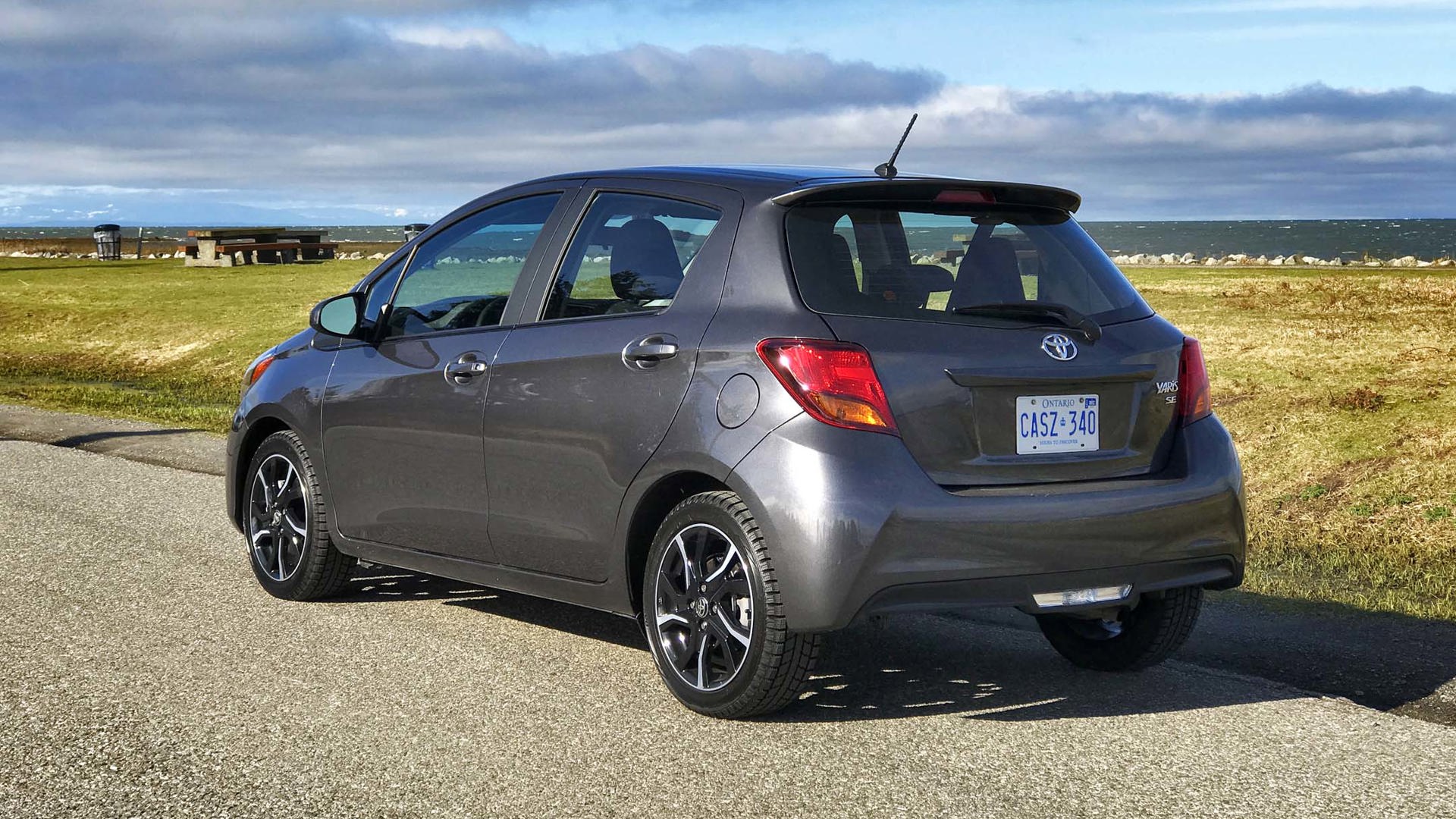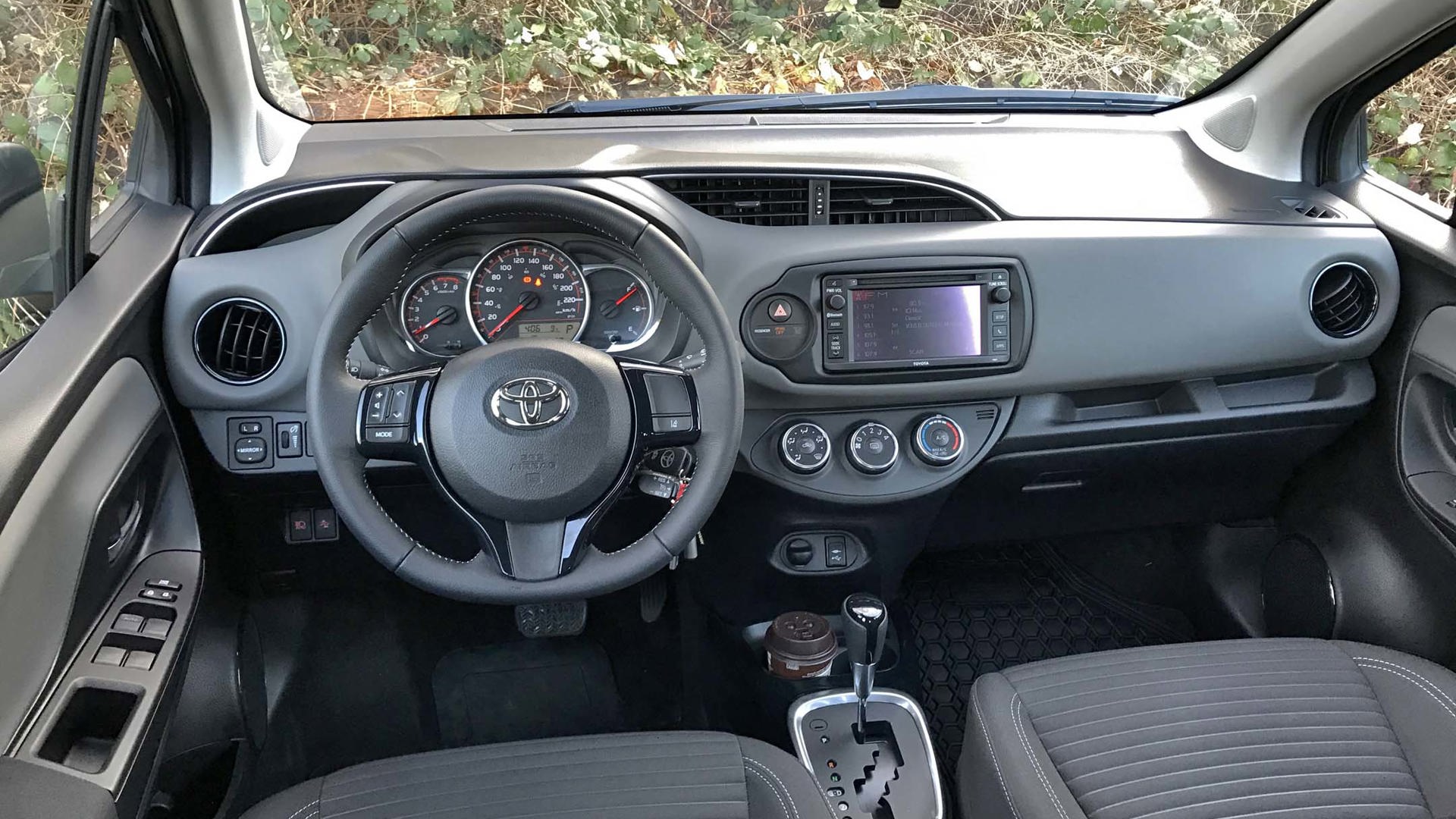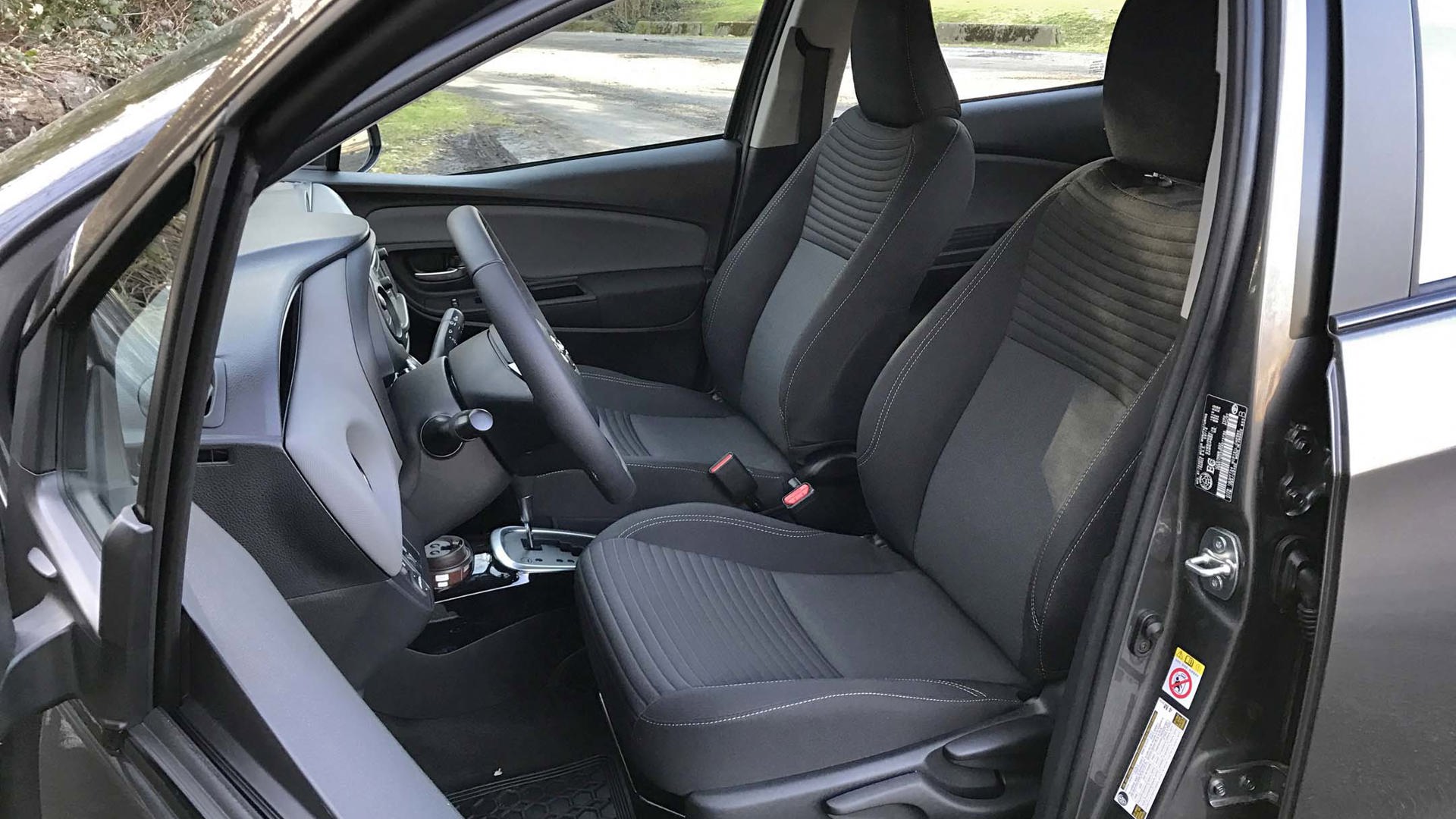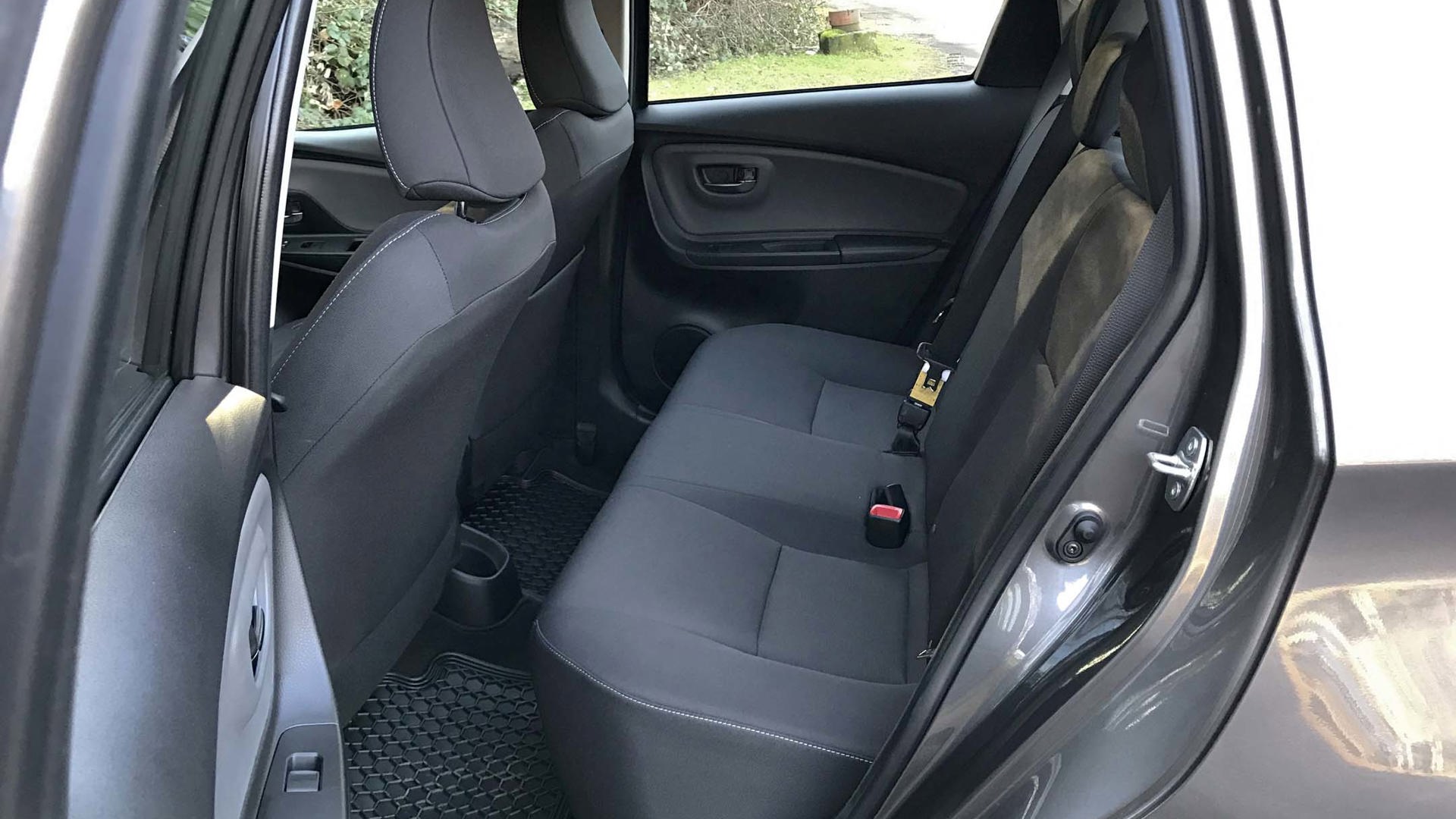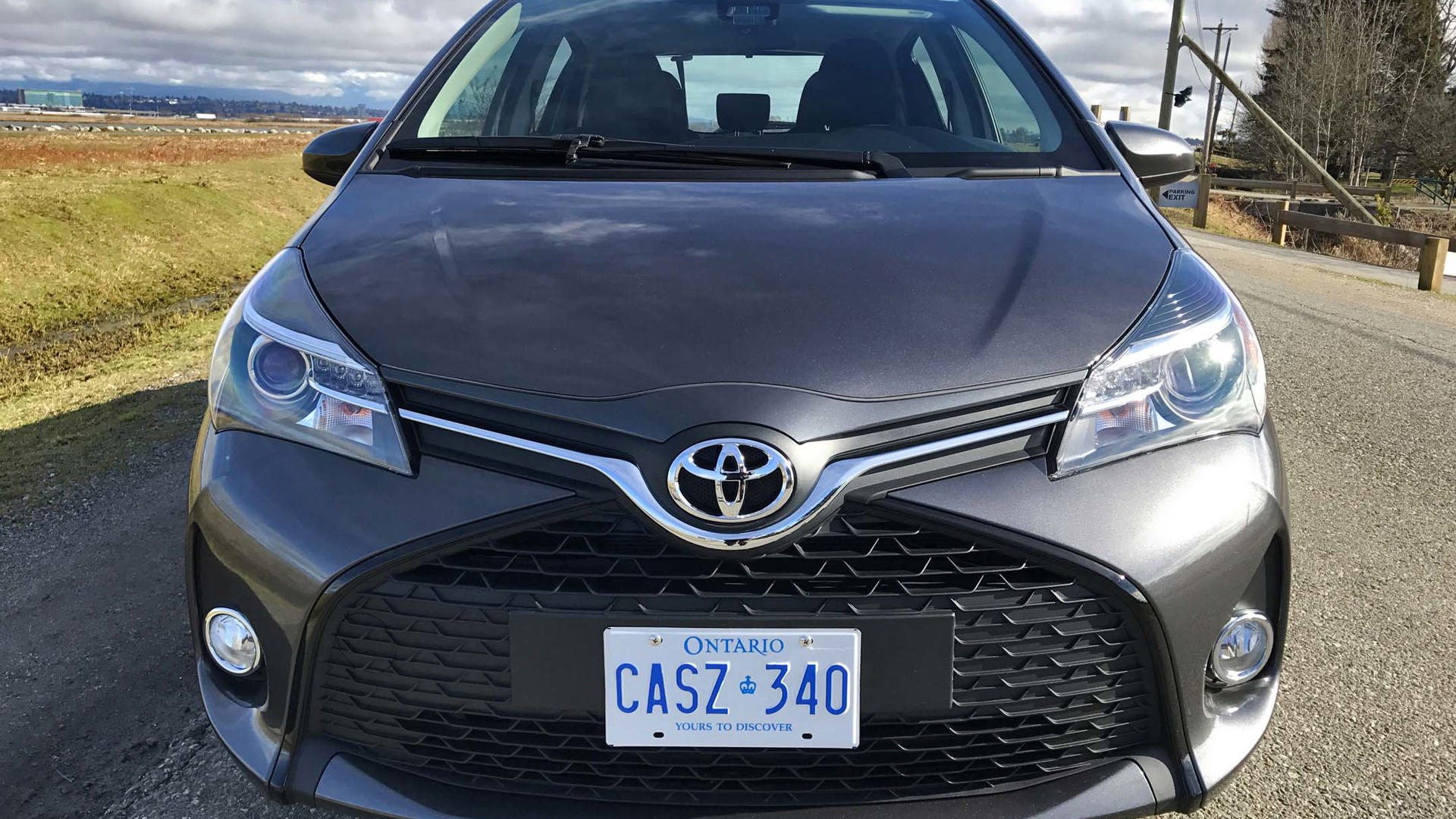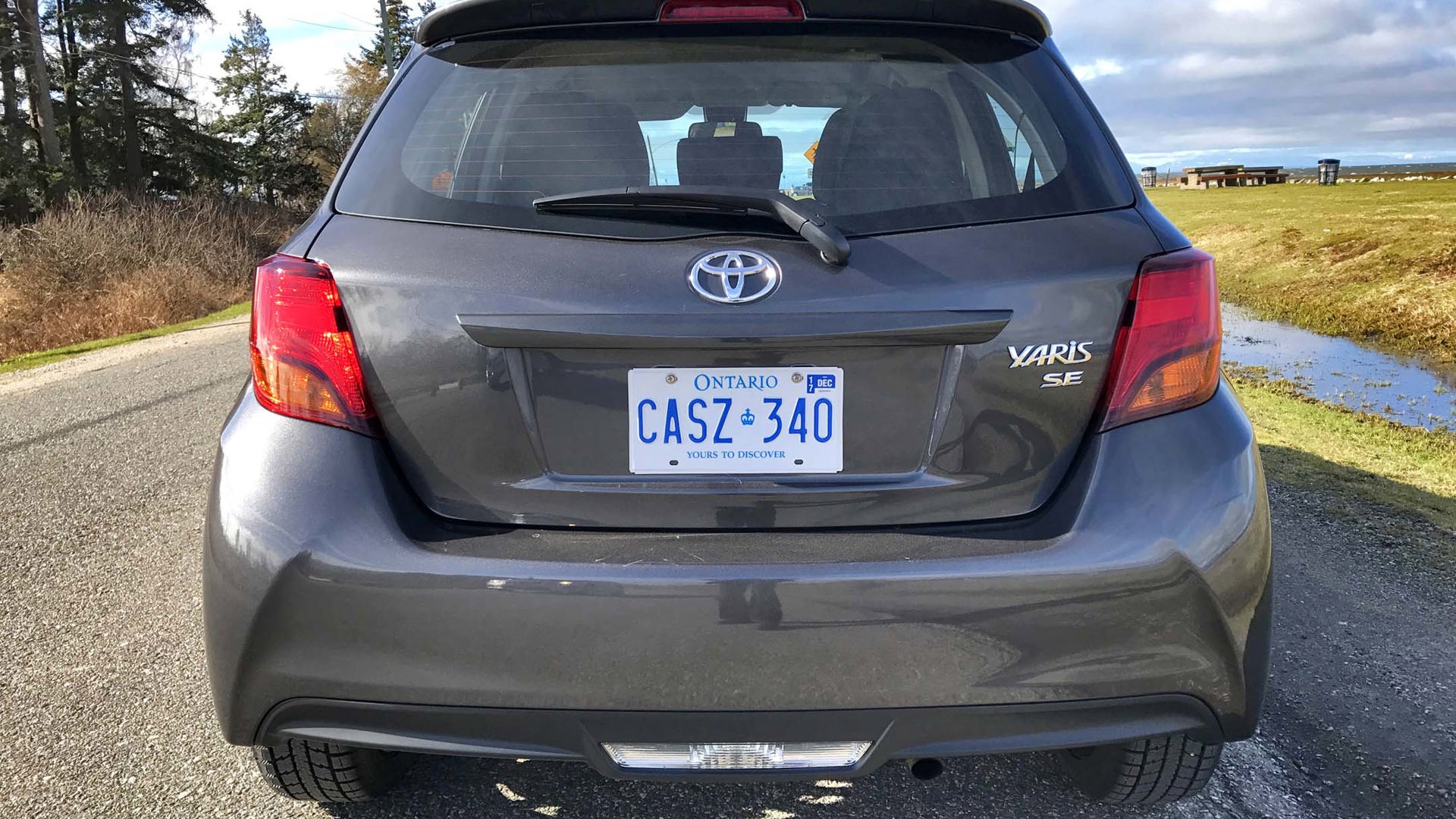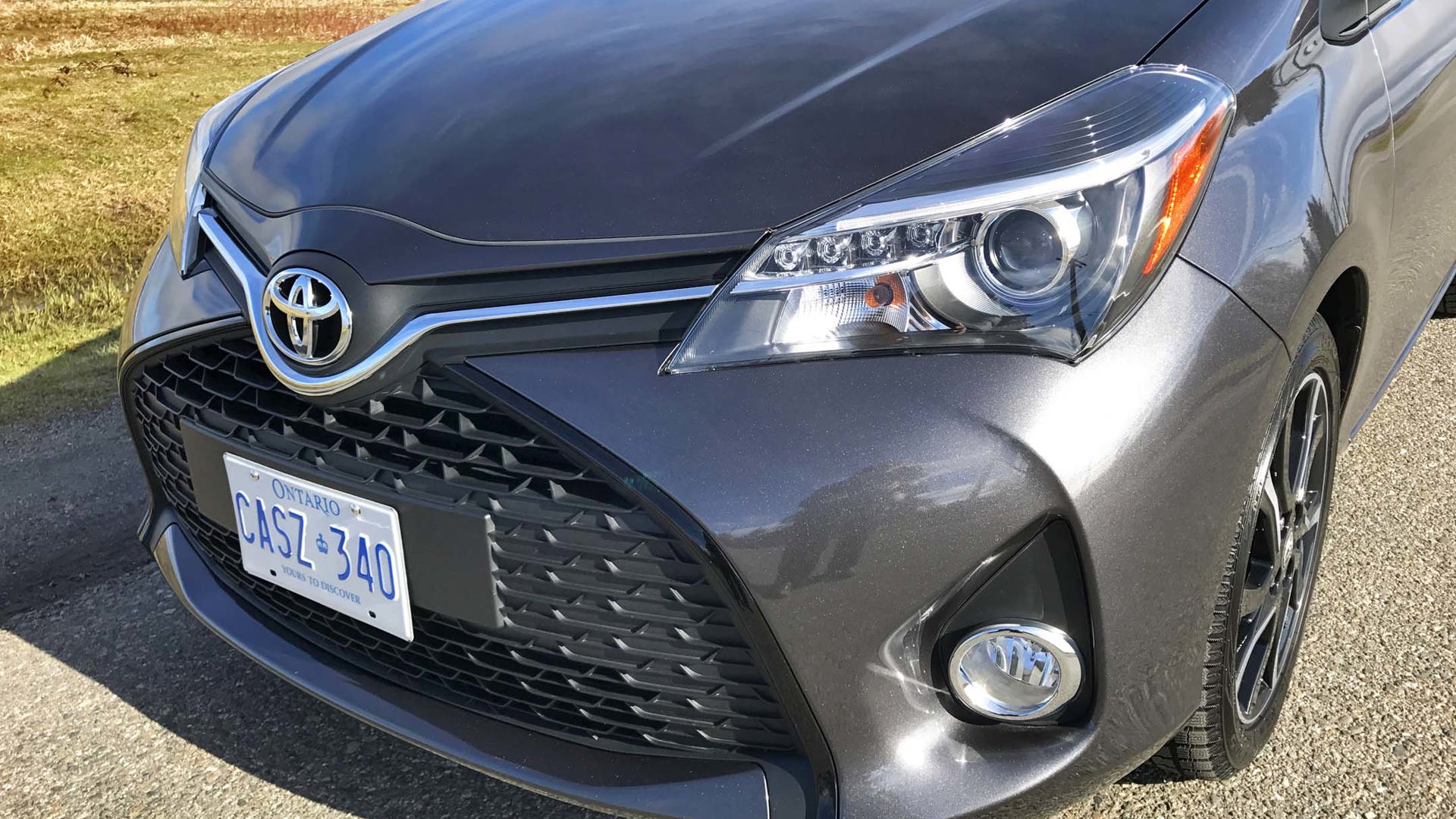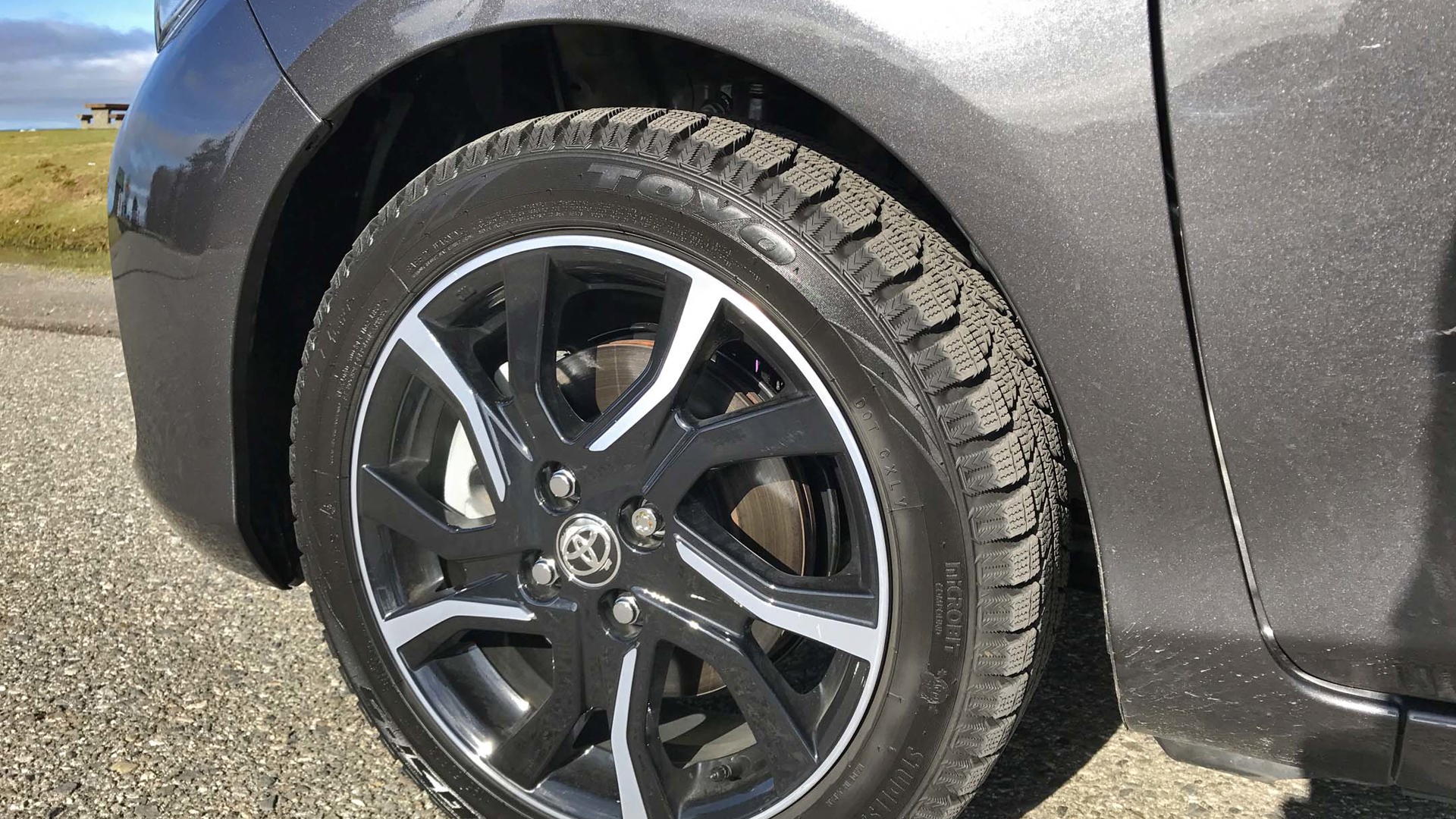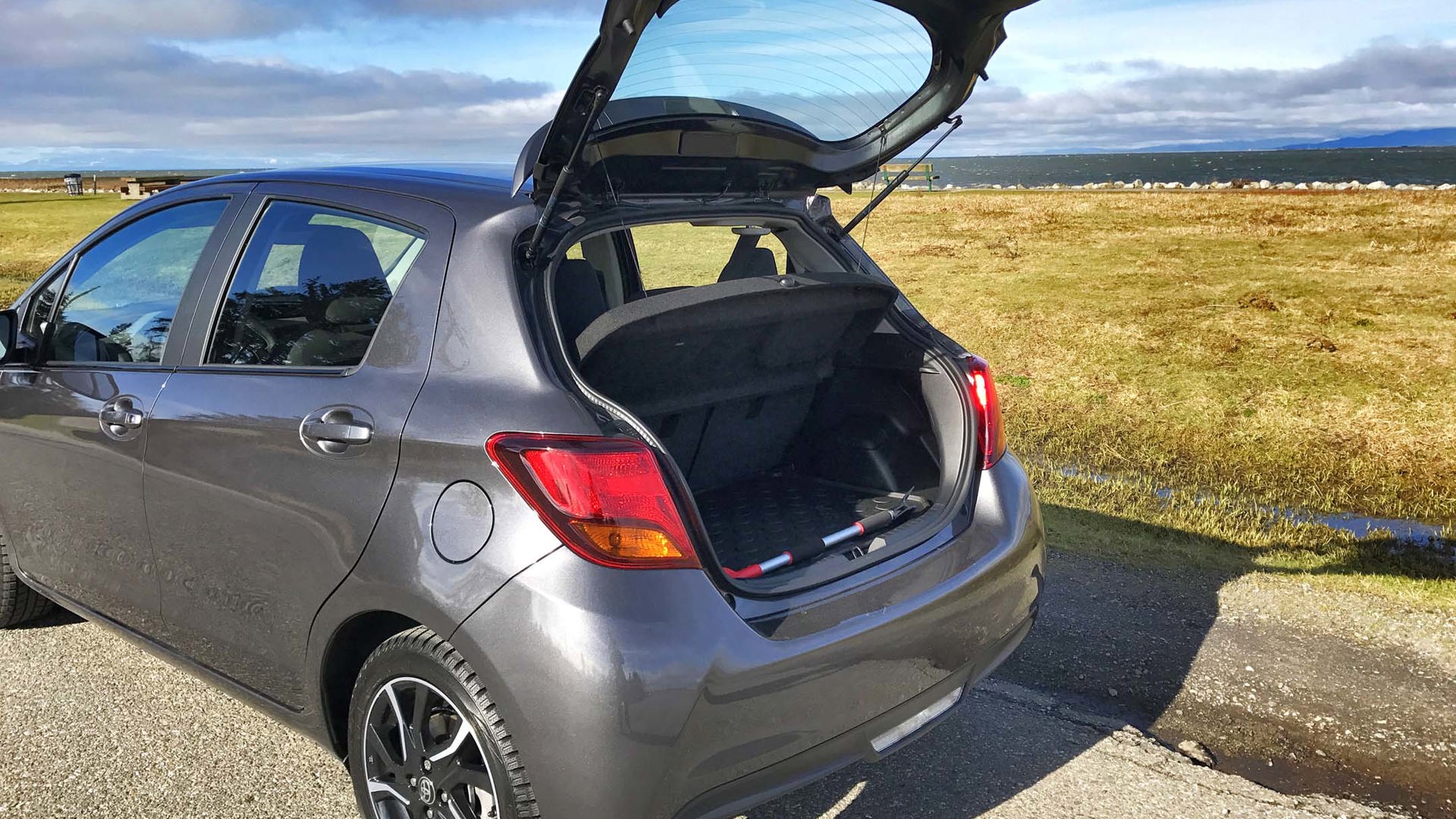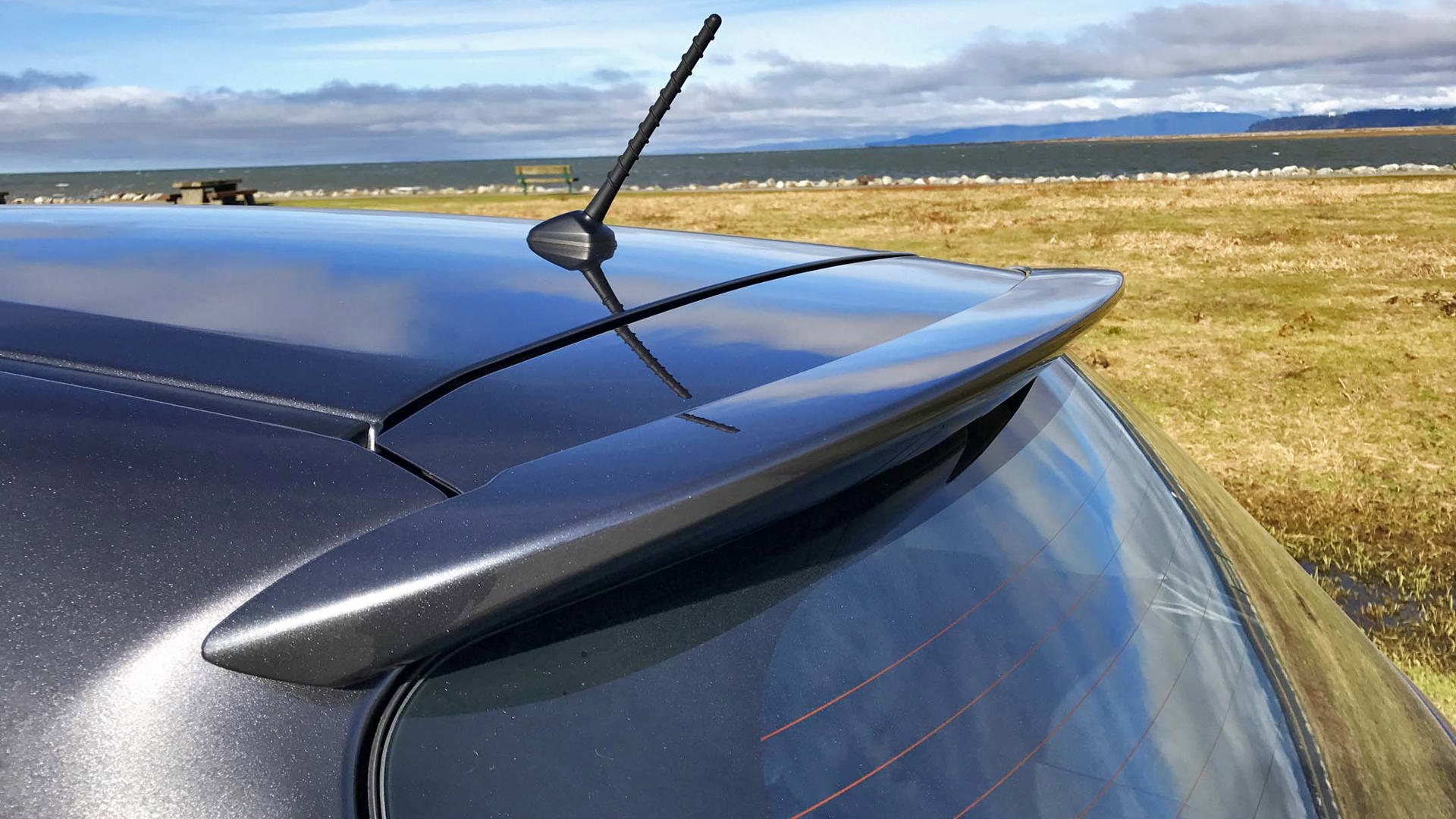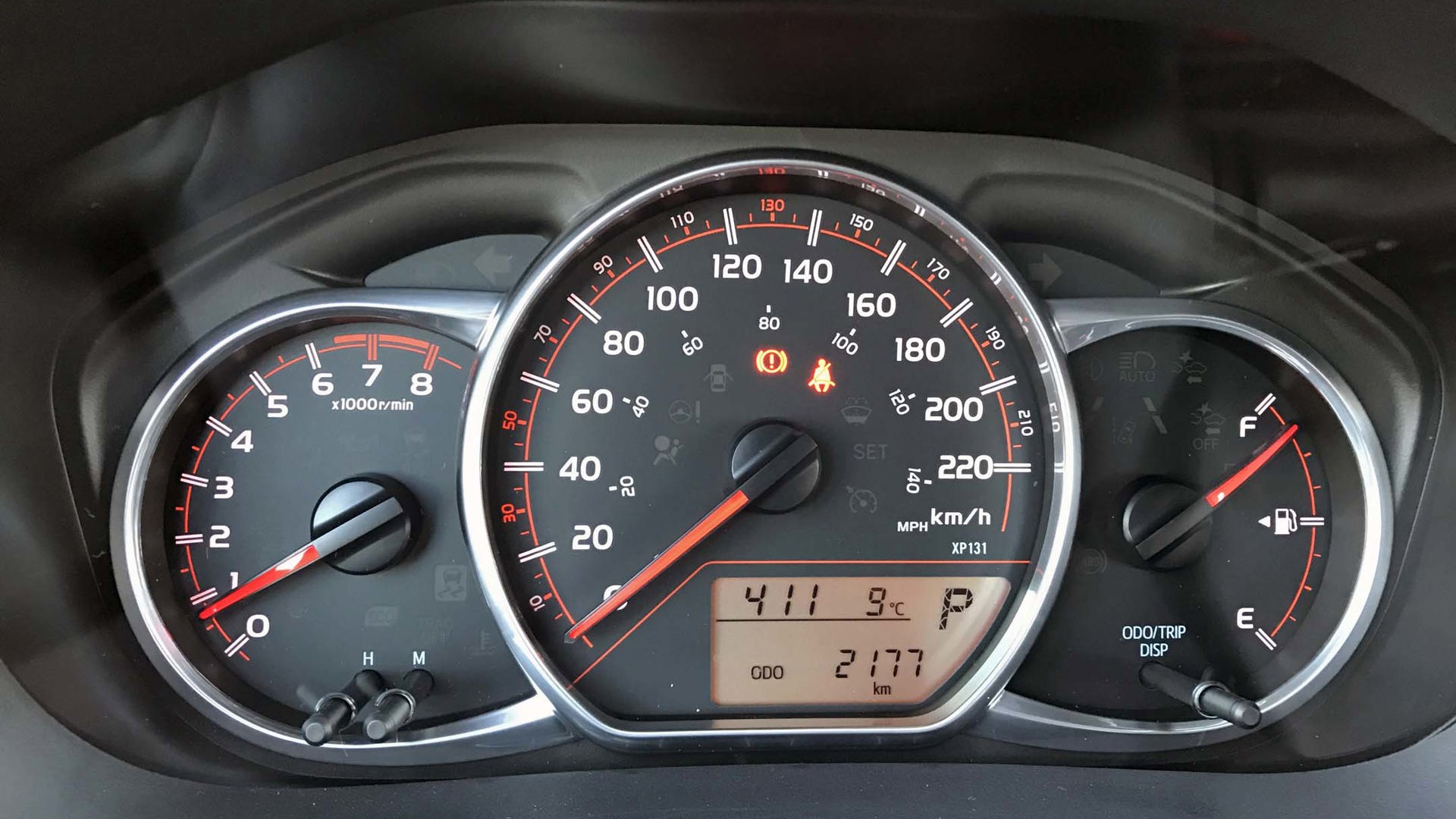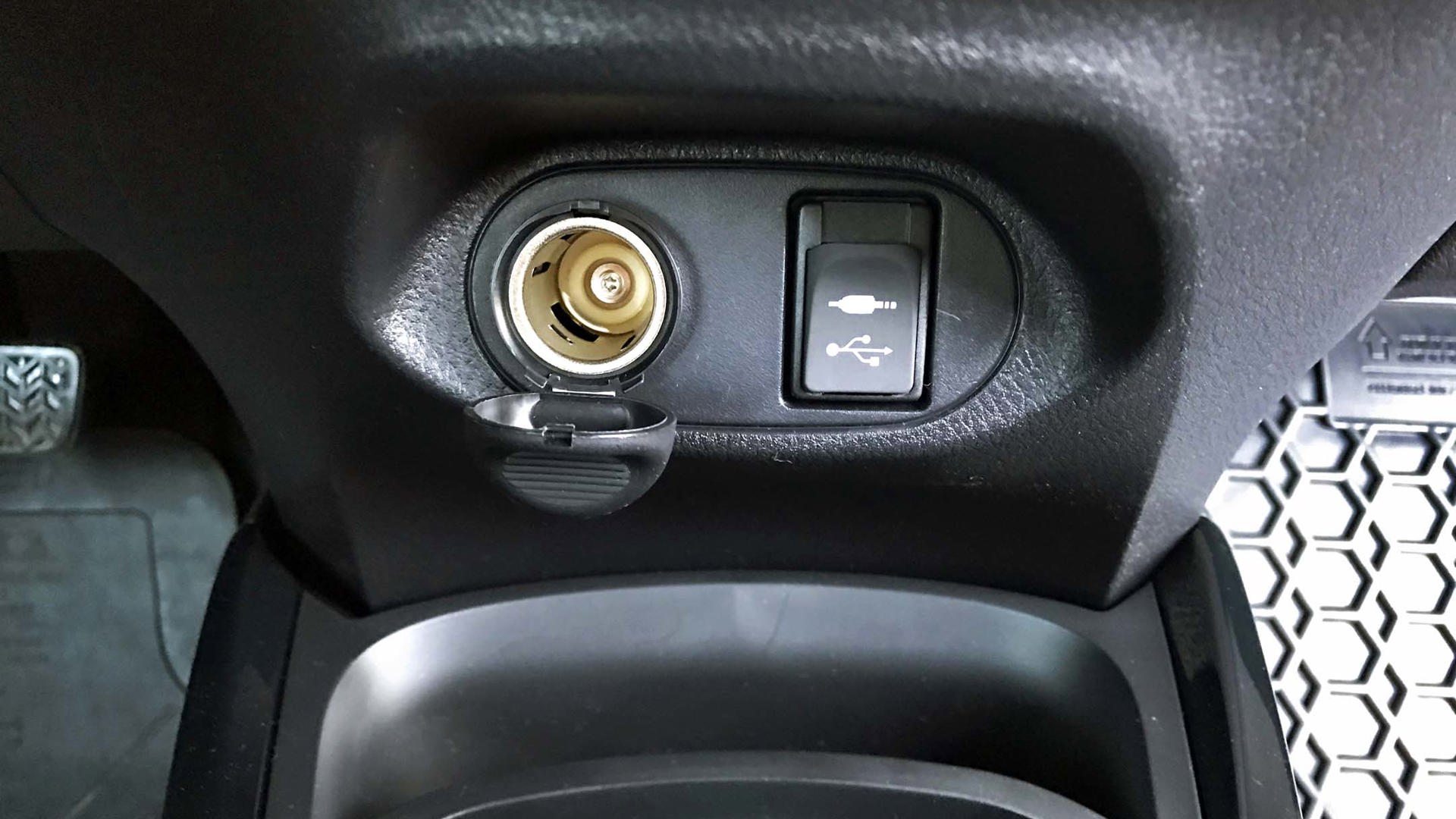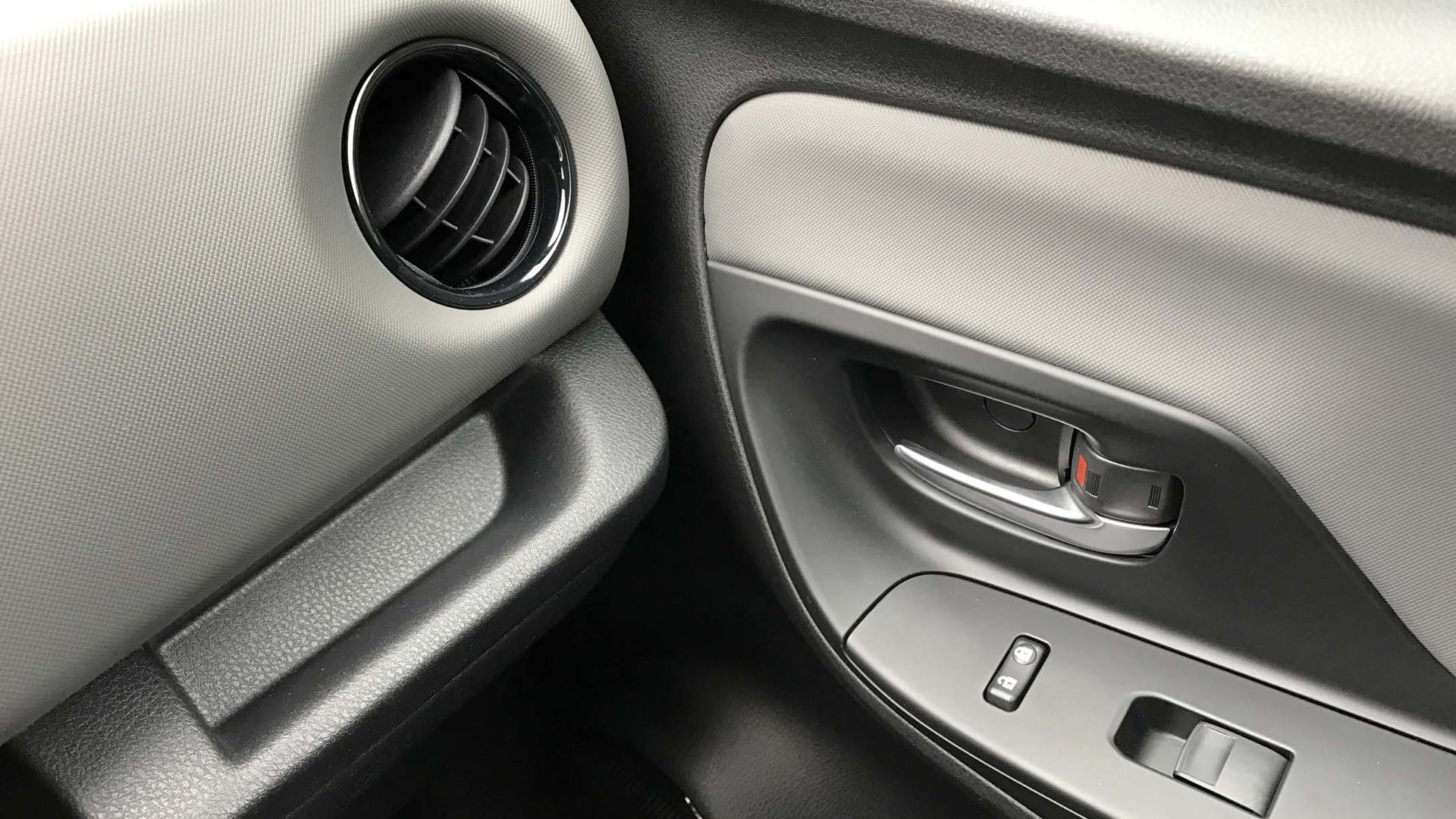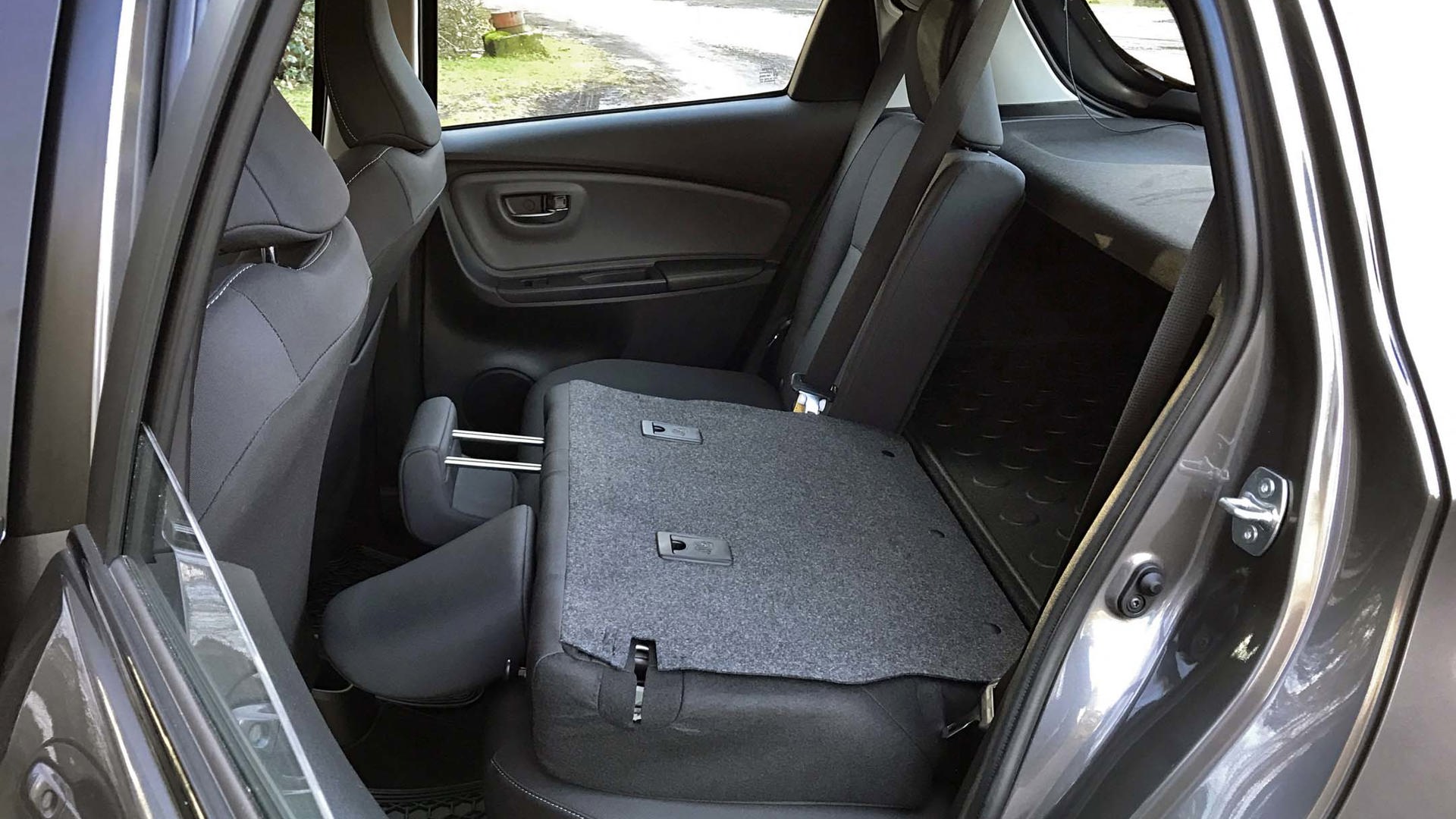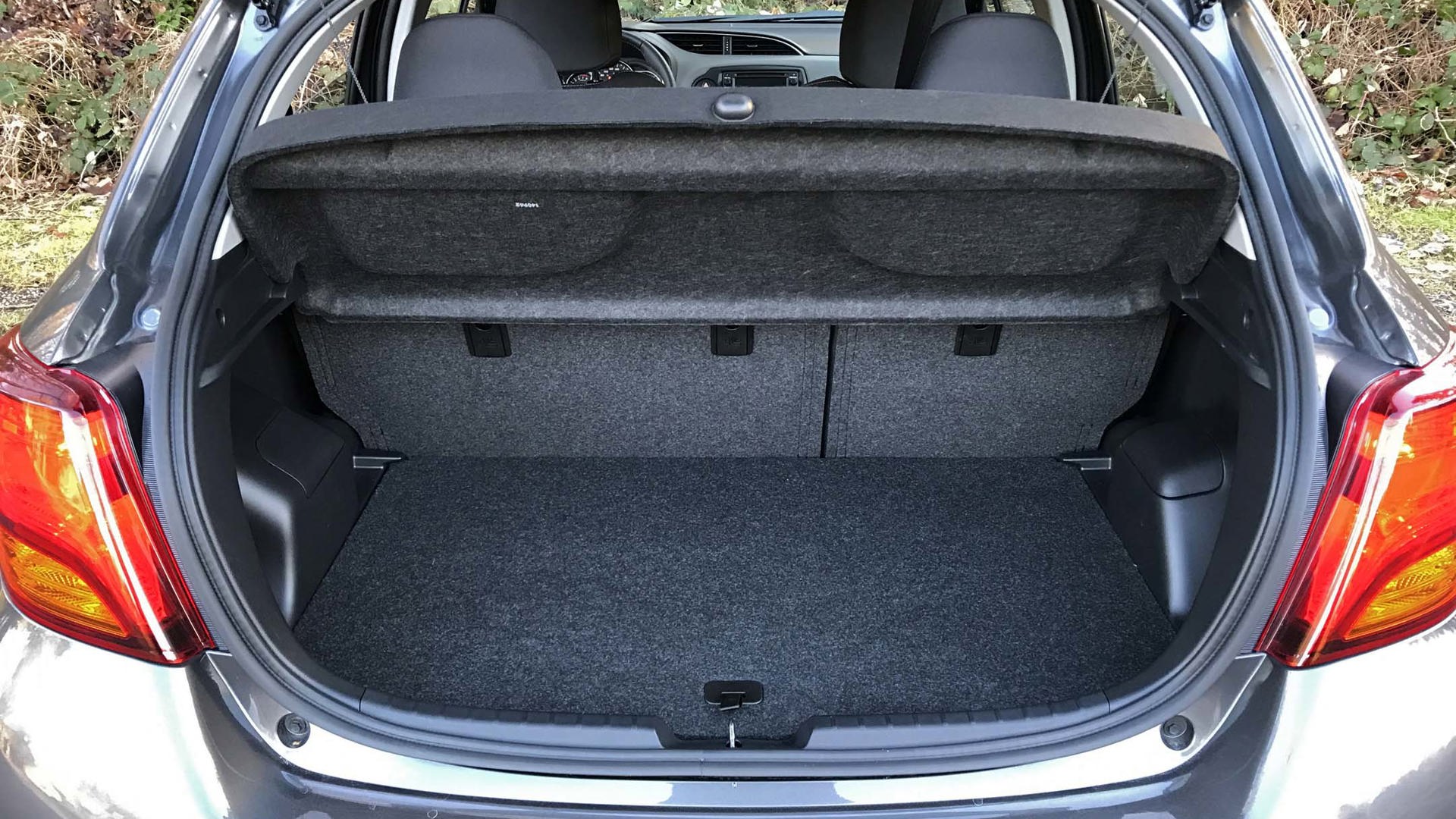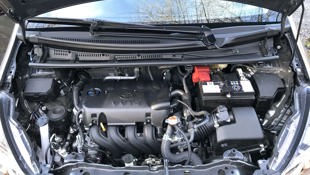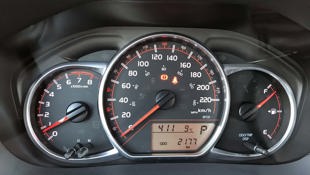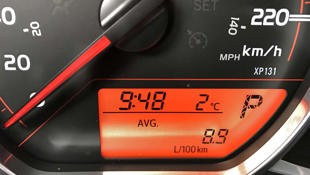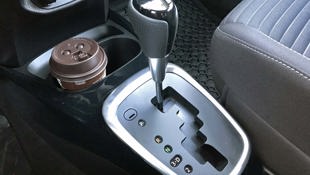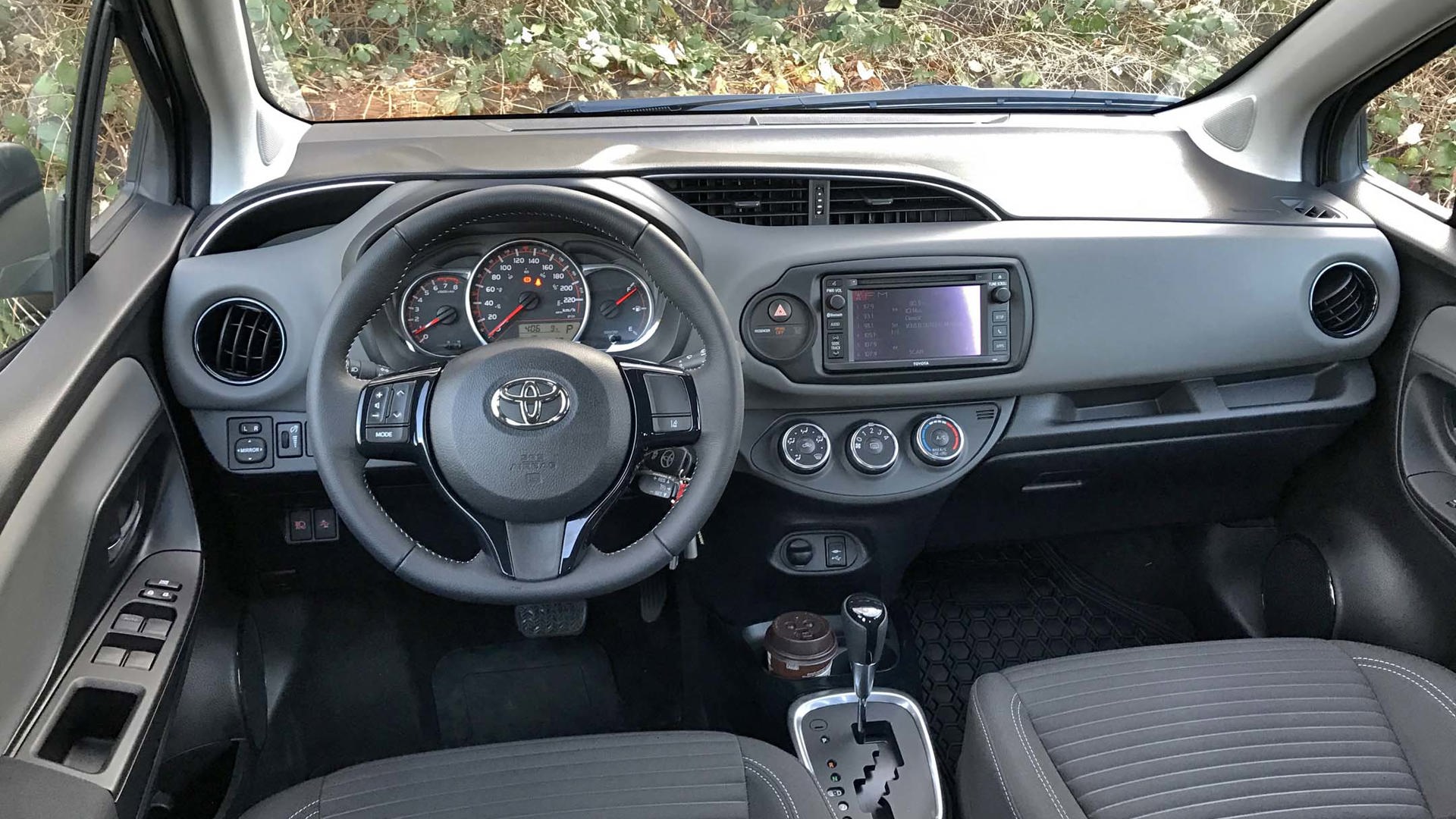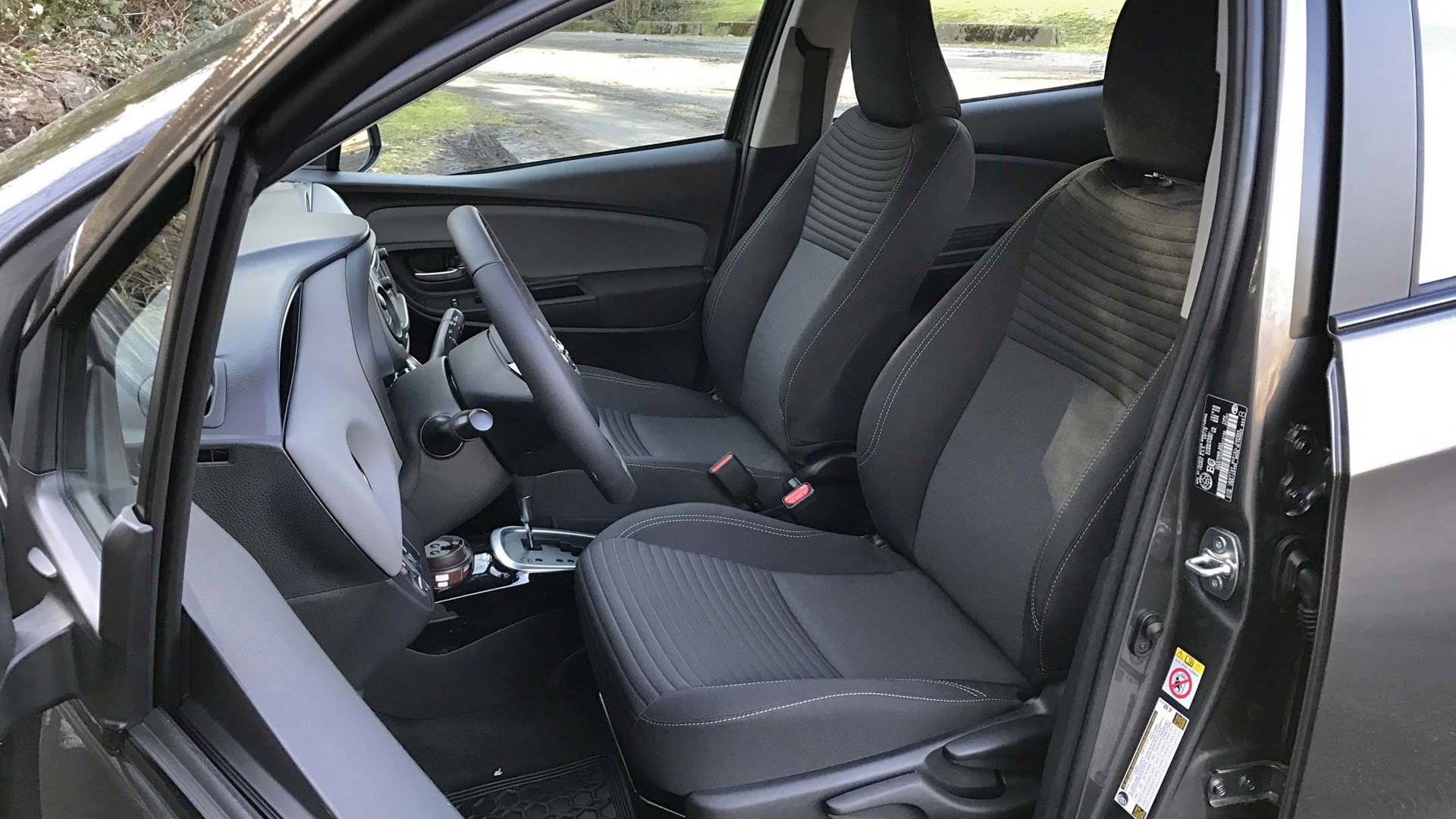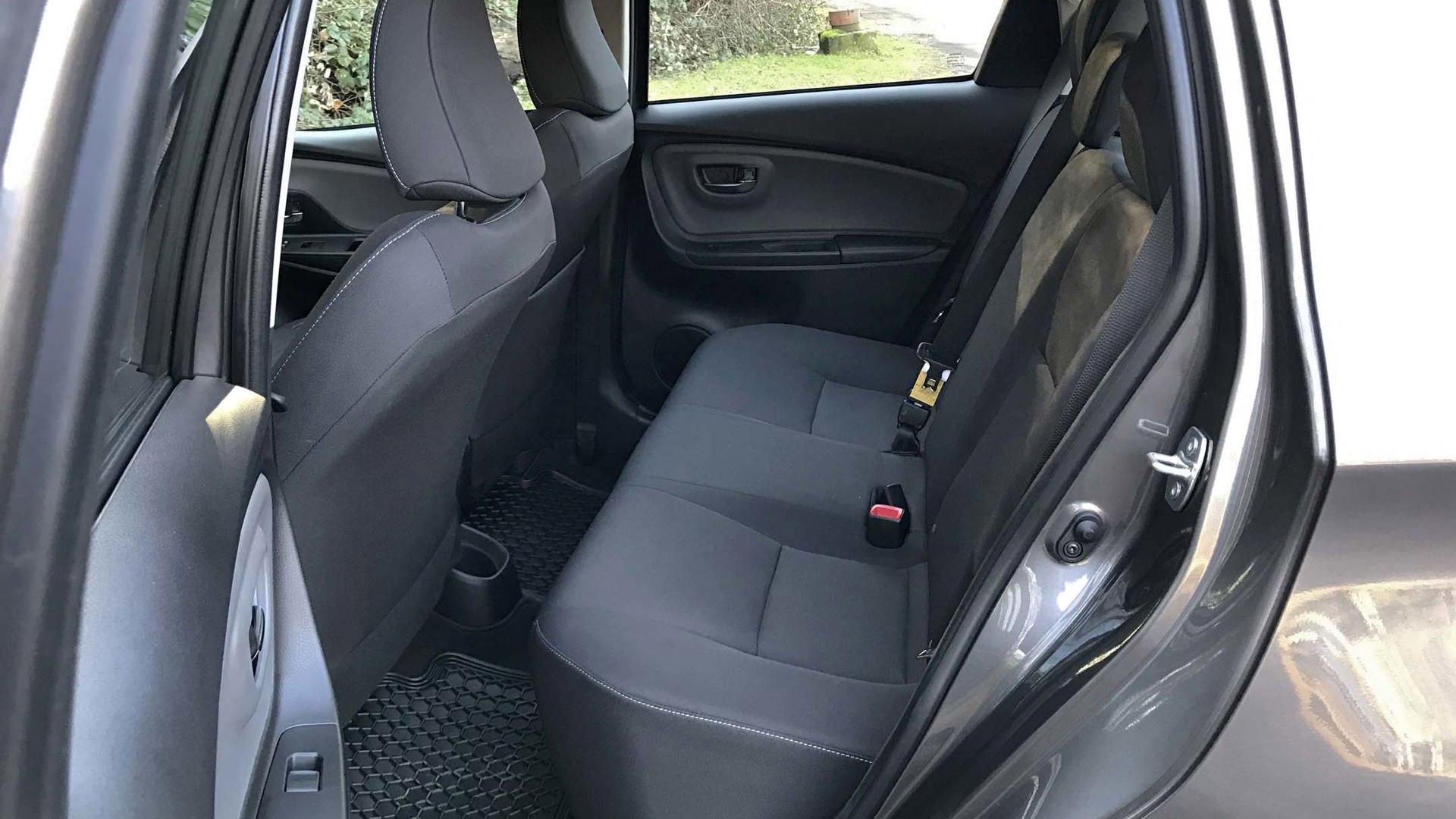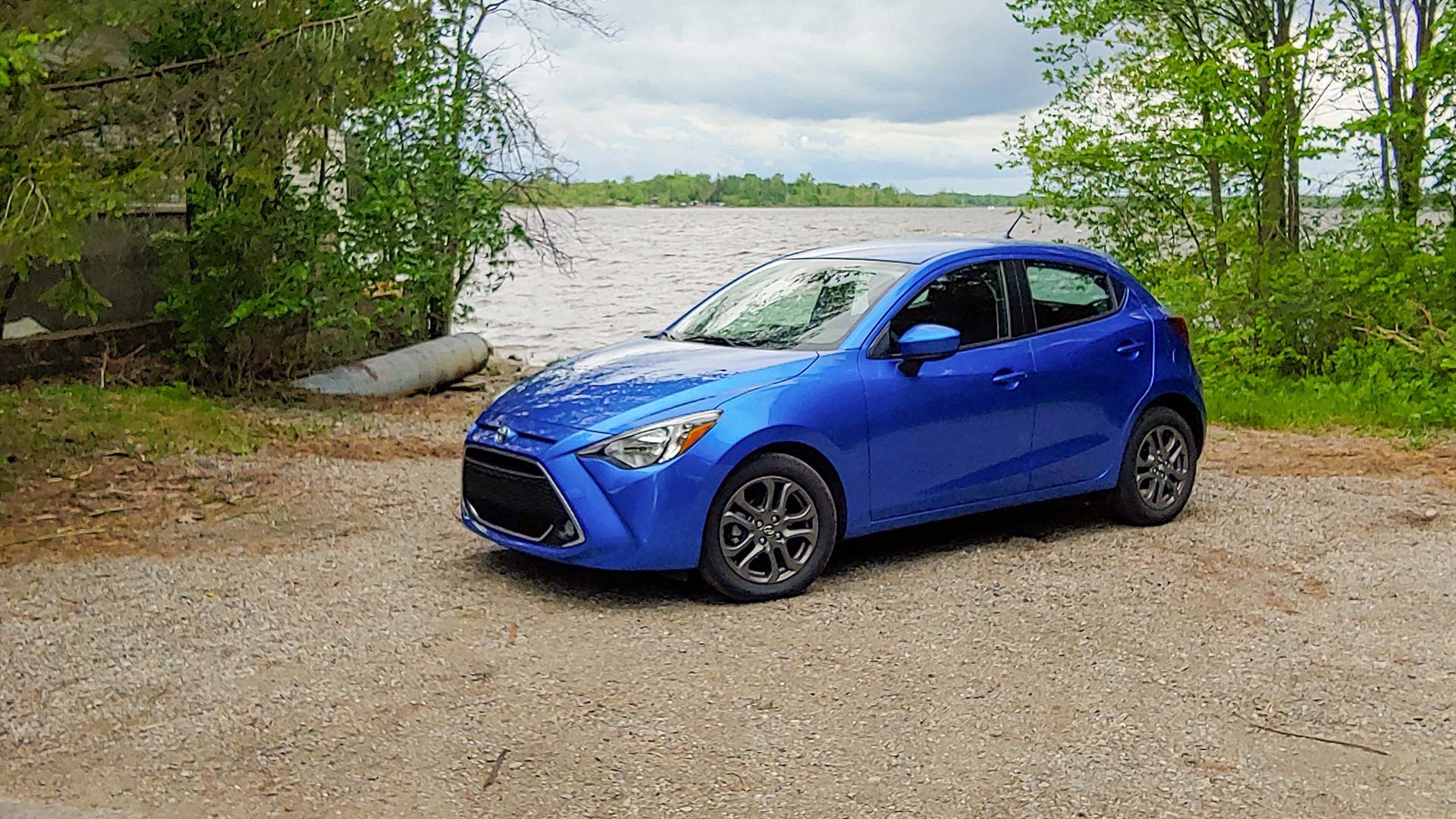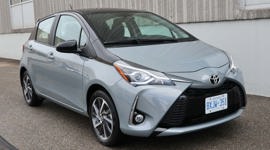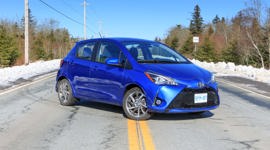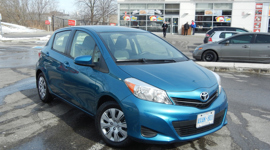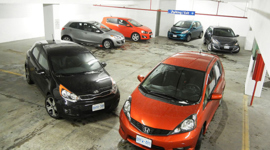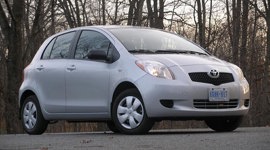 AutoTrader SCORE
AutoTrader SCORE
-
STYLING6/10
-
Safety7/10
-
PRACTICALITY6/10
-
USER-FRIENDLINESS6/10
-
FEATURES6/10
-
POWER6/10
-
COMFORT6/10
-
DRIVING FEEL5/10
-
FUEL ECONOMY6/10
-
VALUE7/10
If you head down to your local Toyota showroom and test drive a 2017 Toyota Yaris Hatchback, you’ll probably like its small size, nimble road manners, reasonable fuel economy, hatchback versatility and low price.
The Yaris hatchback has fallen behind its newer rivals
But if you test drive one of its key competitors such as the Honda Fit, Nissan Versa Note or Hyundai Accent, you’ll soon realize that the Yaris hatchback has fallen behind its newer rivals. The Yaris Hatchback’s chassis and powertrain date back to 2006, its cabin and cargo area are smaller and less accommodating than its competitors, and it lacks many of the features offered by its rivals.
New safety features but other stuff missing
While we’re happy that Toyota added its Pre-Collision System, lane-departure alert and automatic high-beams to the Yaris hatchback for 2017, we’d seriously think about trading those safety nannies for these unavailable features: a telescoping steering wheel, heated front seats, adjustable lumbar support, driver’s armrest, variable intermittent wipers, automatic climate control, rearview camera, satellite radio, Apple CarPlay or Android Auto, and a navigation system.
Though the Yaris hatchback will seat four adults comfortably, it ties with the Ford Fiesta for having the smallest cabin in its class. The cargo area too, is smaller than all but the Fiesta’s trunk. 60/40 split folding rear seatbacks are standard but they don’t offer the amazing configurability of the Honda Fit’s rear seats nor the roomier cargo volume of its competitors.
And then there’s the powertrain: the Yaris’ aging 106 hp 1.5-litre DOHC four-cylinder engine has a reputation for reliability, but it has the least horsepower and torque in its class. As well, the Yaris’ standard five-speed manual and optional four-speed automatic transmissions have been eclipsed by newer competitors’ standard six-speed manual and optional six-speed automatic or CVT transmissions.
With the lightest curb weight, the smallest engine with the least horsepower, you’d expect the Yaris hatch to have the best fuel economy too. Nope. Equipped with the optional four-speed automatic transmission its official NRCan ratings of 7.9 L/100 km city/6.8 highway/7.4 combined are thirstier than the CVT-equipped Nissan Versa Note (7.6/6.2/7.0) and Honda Fit (7.0/5.9/6.5). It is slightly more frugal than the Ford Fiesta (8.7/6.4/7.6), Hyundai Accent (8.9/6.6/7.9) and Kia Rio (8.8/6.5/7.8), all more powerful cars equipped with six-speed automatics.
Real-world fuel economy varies
After a week driving the Yaris hatchback in a 50/50 mix of city/highway driving, our real-world fuel consumption was disappointing. With the temperature hovering between 5 and 10 degrees Celsius, we observed average fuel consumption of 8.9 L/100 km. That seems high, but it’s consistent with our previous winter test drives. Our test of a 2015 Yaris hatchback at near-zero temperatures produced an average fuel economy of 9.5 L/100 km while a test drive of a 2013 Yaris hatchback conducted in February showed 8.9 L/100 km.
Some of the blame must go to its lack of direct fuel injection and the absence of extra gears in the transmissions, but colder temperatures, poor weather and road conditions also appear to be factors. When we tested a 2015 Toyota Yaris hatchback in September, we averaged 7.5 L/100 km in the city and 6.5 L/100 km on the highway for a combined rating of 7.0 L/100 km, better than the official ratings of 7.9 city/6.8 hwy.
Though not the most powerful engine in its class, the Yaris’ 1.5-litre engine does offer sufficient power and acceleration for typical city and freeway duties and though it’s a bit noisy during acceleration, that’s not unusual in a small car. We found it reasonably quiet at cruising speeds.
A five-speed manual transmission is standard in all three Yaris trim levels, CE, LE and SE. The Yaris’ optional four-speed automatic transmission, despite having two fewer gears than some of its competitors, is well-matched to this engine offering smooth, timely shifts. Indeed, many drivers may prefer this four-speed automatic to the continuously variable transmissions offered in the Fit and Versa Note.
In top gear at 100 km/h, the engine turns over approximately 2,600 rpm, a bit high by today’s standards. The shift lever’s gated shift pattern allows the driver some manual control; for example, you can shift from fourth to third by simply slapping the gear lever to the left. You can also pull back another notch to second gear, and for steep hills, the lever can be flipped to the right and down for Low gear.
Small but not particularly sporty
For a small car, the Yaris Hatchback has a fairly comfortable ride without the choppiness you might expect from a shorter wheelbase. However, its handling and steering is uninspired when compared to the Fit or Fiesta. The Yaris Hatchback feels strangely cumbersome and agricultural when cornering and there’s a definite “clunk” when the steering wheel is turned all the way right or left. It’s just not sporty to drive.
With standard 15-inch tires, the Yaris Hatchback CE and LE trim levels have a deliciously tight turning diameter of just 9.6 metres (31.5 ft.) but Yaris SE models with 16-inch tires have a much wider turning diameter of 11 metres (36.1 ft.).
The driver’s visibility to the front and sides is good and the Yaris features a single wiper blade that clears the entire windscreen except for a small un-wiped area at the top right – which can be rather irritating for the front passenger. The big front wiper has an intermittent setting, but it’s a fixed wiping interval rather than a variable wipe setting. The driver’s visibility through the rearview mirror is good – the centre head restraint lowers all the way down – and there is a rear wiper, washer and defroster. However, the over-the-shoulder view to the right is obstructed by a thick C-pillar and a blank panel in the rear side window as well as a large solid right-rear head restraint. This can make lane-changing difficult especially as the Yaris Hatchback doesn’t have a blind-spot warning system.
New pre-collision warning system is standard
New for 2017 is a Pre-Collision System (PCS) that uses camera and laser radar sensors mounted in the upper windscreen to detect potential frontal collisions. If a collision is imminent at speeds between 15 and 140 km/h, it will alert the driver with audible and visual warnings and automatically apply additional braking force when the driver brakes. If the driver fails to brake at speeds between 10 and 80 km/h, the PCS will automatically brake the car to help avoid a collision. Using a button on the lower dash, the driver can manually select one of three following distances for activating warnings. Toyota is careful to point out that PCS is not a collision-avoidance system but rather a collision-mitigation system that can reduce the impact of a collision if it is unavoidable.
During my week’s test drive, the PCS warnings activated only once when I was approaching a car stopped in the lane ahead of me. A warning beep sounded and a light flashed in the gauge cluster alerting me to the danger. This definitely caught my attention.
Also new for 2017 is a lane-departure alert system that uses the camera in the windshield to monitor the white or yellow lane markings on both sides of the car. If the vehicle drifts out of its lane unintentionally at speeds above 50 km/h, four short loud beeps warn the driver. I tried to activate it by wandering across left and right lanes but was unsuccessful, perhaps because I did it intentionally instead of unintentionally (which is the way it is designed to function). The system can be deactivated by pressing a button on the steering wheel. It should be noted that this system does not automatically steer the Yaris back into its lane.
Automatic high-beams are also new for 2017. When driving at night with the automatic high-beams on at speeds above 34 km/h, the camera in the windscreen detects the headlights of oncoming vehicles and the taillights of vehicles ahead, and automatically dips the Yaris high beams until the oncoming car has passed or the car ahead has moved further away. It then automatically raises the high-beams again. Note that the driver must press a button to activate or de-activate the automatic high-beams.
Cabin has room for four adults
Though the Yaris Hatchback is not as roomy as many of its rivals, its cabin is big enough for four average-size adults because of its tall roof and upright seating positions. The driver sits tall relative to the steering wheel and dashboard and the driver’s seat has a manual seat height adjuster. There is no driver’s lumbar adjustment, but there is a bulge in the lower seatback that helps support the driver’s lower back area. In the SE, the front “Sport” seats are well-bolstered and reasonably comfortable for drives under an hour. However, finding a perfect driving position is difficult because the tilt steering wheel doesn’t telescope in and out. As well, there is no folding armrest between the front seats, and heated seats are simply not available.
For outboard rear passengers, the rear bench seat is comfortable enough but there is no folding centre armrest. “Sitting behind myself” I had about 25 mm of knee-room and plenty of head-room and leg-room. However, the back seat is too narrow for three adults across (though there are three three-point seatbelts and three head restraints).
The rear 60/40 split seatbacks fold down almost flat by pulling up on a lever on top of the seatbacks. This configuration means that you can seat one or two people in the back seat while transporting long objects like hockey sticks on the other side.
Behind the rear seats, the Yaris Hatchback has a floor-to-ceiling cargo volume of 442 litres. That’s smaller than the Versa Note (532 L), Fit (470 L), and Accent (487 L) but roomier than the Fiesta (421 L). The rear tailgate lifts up easily and a removable privacy cover is included. The cargo floor and rear seatbacks are lined in what looks like cheap carpet underlay while the side walls are bare plastic. Under the floor is a temporary spare tire and jack.
Cabin missing some popular features
The top SE trim (our test car) has better-quality cloth upholstery than the CE and LE trims: a sturdy coarse black cloth with white stitching, along with a leather-wrapped steering wheel and shift knob and a splash of glossy piano black trim on the steering wheel spokes and gear knob.
The Yaris’ busy dashboard design is a mix of hard black plastic and a padded grey material on the dash-front and in the door inserts. Behind the steering wheel, a large central speedometer is flanked by a fuel gauge and a tachometer (in CE models, the tachometer is new for 2017). The speedometer includes an integrated trip computer with useful information such as average fuel consumption, range and outside temperature. To toggle between the values, the driver needs to reach over the wheel and press a tiny stalk sticking out of the fuel gauge which is kind of awkward.
A 6.1-inch touchscreen in the centre of the dash is standard in all Yaris hatchbacks. It displays audio and phone info in easy-to-read large letters and “tiles”, and phone calls can be voice-activated. However, the screen doesn’t have a rear-view camera, and navigation is not available. Audio options include AM/FM radio, CD player, Bluetooth audio, USB and auxiliary ports for music players, but Apple CarPlay and Android Auto aren’t offered and neither is Sirius/XM satellite radio.
Air conditioning is standard in LE and SE trims but not available in the base CE trim. Automatic climate control, something that’s standard on some of its competitors, is not available in the Yaris Hatchback.
Storage space in the cabin is limited to the glovebox, a slot ahead of the front cupholders, a coin slot on the dash near the door, and two open slots on the passenger-side dash. It’s surprising that even the top SE trim level doesn’t have a centre armrest and storage container between the front seats.
2017 pricing and features
Starting at $15,475 with a five-speed manual transmission, the 2017 Toyota Yaris Hatchback CE has two doors while all of its competitors offer four doors in their base models. With the optional four-speed automatic, the CE’s price rises to $16,470. Standard in the CE are 15-inch all-season tires and steel wheels, front disc/rear drum brakes with ABS and Brake Assist, 6.1-inch centre touchscreen, Bluetooth phone and audio, AM/FM/CD with four speakers, power windows and locks (but not keyless entry), split-folding rear seatbacks, trip computer, nine airbags and the Pre-Collision System, lane departure alert and automatic high-beams.
Mid-level LE models ($16,815) have four doors and are available with a five-speed manual transmission or optional four-speed automatic. In addition to the features found in the CE, the LE adds air conditioning, keyless entry, cruise control, and power heated outside mirrors.
The top SE trim adds 16-inch all-season tires and alloy wheels, rear disc brakes, rear spoiler, projector halogen headlights, LED daytime running lights, front fog lights, intermittent rear wiper, two extra audio speakers, leather-wrapped steering wheel and shift knob.
While the 2017 Toyota Yaris Hatchback lags behind its rivals in many respects, it does offer the advantages of a smaller footprint, Toyota’s reputation for reliability, and an excellent resale value.
Just don’t test drive any of its competitors.
The 2017 Toyota Yaris Hatchback is built in Valenciennes, France.
| Engine Displacement | 1.5L |
|---|---|
| Engine Cylinders | 4 |
| Peak Horsepower | 106 hp |
| Peak Torque | 103 lb-ft |
| Fuel Economy | 7.9/6.8/7.4 L/100 km cty/hwy/cmb |
| Cargo Space | 433 L |
| Model Tested | 2017 Toyota Yaris SE Hatchback |
| Base Price | $19,430 |
| A/C Tax | $100 |
| Destination Fee | $1,565 |
| Price as Tested | $21,095 |
|
Optional Equipment
None
|
|


